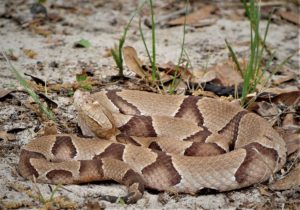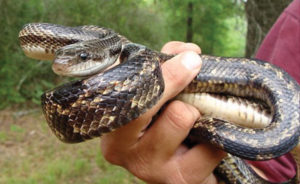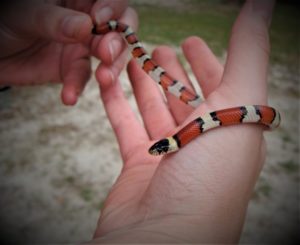
The copperhead is among four venomous snakes, including rattlesnakes, cottonmouths and coral snakes, that people should watch for while walking. Their pattern blends well with fallen leaves and debris on the ground. (Texas A&M AgriLife Extension photo by Maureen Frank)
Rising temperatures mean the chances of coming across a snake are also rising.
Rapid urbanization and higher-than-normal amounts of rain are a combination that increase the likelihood of human-snake encounters, and more interactions can lead to more bites.
Maureen Frank, Ph.D., Texas A&M AgriLife Extension Service wildlife specialist, Uvalde, has some tips on how to avoid snake bites and deal with objects and places around homes and properties that may attract snakes.
Snakes, whether we like them or fear them, are becoming more active around the house and in their natural habitat this time of year. It’s still a little cool, but snake activity will increase as temperatures climb.
People can encounter snakes while walking trails, camping or just doing summer yardwork around the house, Frank said. There’s little to fear about snakes if a few basic precautions and principles are applied before and during an encounter.
Snakes are integral to Texas’ array of regional ecosystems. While many Texans view them as a dangerous pest, they are an important predator of insects and small mammals. There are around 75 snake species in the Lone Star State, but only about a dozen are venomous.
Even though most species are non-venomous, Frank said her best advice is to avoid contact with any snake. Snakes are typically not aggressive and will typically escape an area if they hear someone approaching.
She said the best ways to avoid snake bites is to watch where you step or reach and to keep your distance if you see one.
“When you encounter a snake, it’s best to just leave it alone,” Frank said. “Most bites occur when a person is trying to handle the snake or trying to kill it. It’s best to give them plenty of room and let them go on their way.”
Where and when you might encounter a snake

Most Texas snakes, like this Texas rat snake (Elaphe obsoleta), are not venomous and try to avoid people. (AgriLife Extension)
Frank said recent heavy rains and flooding could increase the potential for encounters with snakes. Flooding can push snakes from burrows and typical habitat to higher ground and create hiding places in those areas.
“Heavy rains can push snakes from low-lying areas, and flooding can wash debris onto properties that can become good places for displaced snakes to shelter,” she said. “So, people need to take special care during cleanup. The thing to remember is to never put your hands or feet somewhere you can’t see and to use tools like hoes or a shovel to move debris or turn it over so you can see that it’s safe to handle.”
Because snakes cannot generate their own body heat, they prefer sun and/or stretching out on warm surfaces like rocks, pavement and other heat-absorbing materials while temperatures are cooler. But in the heat of the summer, they prefer shade, especially from the midday sun.
“People need to take these environmental conditions into account,” she said. “On a cool morning, you may find a snake sunning a rock along a hiking trail or the stones in a walkway or a paved walking trail. When it’s hot, they may be in the shade under a bush or sheet of plywood or in a brush pile. These are things to consider when you go outside.”
Frank said venomous snakes typically do not want to use their venom as a defense. They usually give warnings – like rattlesnakes rattling – before they strike. The Texas Department of Health Services reported that half the reported bites by venomous snakes were “dry,” meaning no venom was injected into the victim.
“A snake strikes because it views you as a threat,” she said. “Producing venom is an energetically costly process, and they only have so much. If they use it, they must make more to hunt for food, and they have to work for every single meal, so striking to defend themselves is something they would rather avoid.”
For more tips on precautions to take related to snakes and flooding, you can find Frank’s publication on this subject at the Texas A&M AgriLife Extension Bookstore.
Reduce snake attractors around the house
There are no chemical repellants proven to deter snakes, Frank said, but there are two things homeowners can do to reduce the likelihood of snakes hanging around a location – remove potential shelter and food.
“It’s best to take the habitat approach and remove the things that attract snakes,” she said. “Cutting the grass, removing brush and debris, and trimming the lower branches on bushes and trees will go a long way in reducing the places a snake might want to hide.”
Research Frank conducted last summer in the Hill Country indicated that snakes use a variety of materials to hide throughout the year, including plywood, sheet metal and other debris. These materials also attract scorpions and spiders, so snakes are just one reason to take caution when cleaning up debris.
Reducing hiding spots for snakes will also reduce hiding spots for the prey they seek, like rats and mice, she said. Cleaning around the house and other structures to remove trash, which is shelter for small prey animals, also helps keep snakes away.
Teach children not to reach inside crevices and under bushes with low-hanging limbs, she said.
“They need to know they shouldn’t reach into a place if they can’t see what might be in there.”
Frank said homeowners should also take precautions to reduce the chance of their pet encountering a snake, such as having them on a leash during walks.
Snakes of Texas

A milk snake’s black, white and red pattern mimics the black, yellow and red pattern of the venomous coral snake. Even non-venomous snakes will bite if they feel threatened, so it’s best to avoid them. (Texas A&M AgriLife Extension photo by Maureen Frank)
Common non-venomous species found throughout Texas include garter snakes, which people also refer to as garden snakes; rat snakes, also known as chicken snakes; and bull snakes. Common venomous snakes include western diamond-backed rattlesnakes, copperheads and the cottonmouth, also known as the water moccasin.
The range of species and likelihood of an encounter differ from region to region and specific locations. For instance, it’s much more likely to see a cottonmouth around bodies of water, like ponds, lakes or creeks, as well as bottomlands that maintain high levels of moisture throughout the seasons.
“Being able to identify a snake can help you avoid danger,” she said. “But the best advice is to keep your distance and avoid contact.”
Frank has published a useful guide to common snake species that can be purchased on the AgriLife Bookstore.
Snake bites
Most snake bites to humans occur to the feet/lower leg or the hands, Frank said.
Despite common misconceptions on how to deal with a venomous snake bite, she said it’s best to stay calm and get to a hospital as quickly as possible.
First, try to identify the snake species, Frank said. This is especially important for coral snakes because the treatments differ significantly from those to treat copperhead, cottonmouth or rattlesnake bites.
“Do not try to kill it,” she said. “The emergency room doctors don’t need it. They just need a decent description of the snake or take a photo of it with your cell phone if it’s safe to do so. If someone else tries to get the snake, you run the risk that the doctor may be dealing with two snake bite victims.”
Frank said the victim should remove clothing like socks if bitten on the foot and items like rings on fingers if bitten on the hand because of swelling.
Tourniquets and suction devices or using other mythologized methods to remove snake venom could do more harm than good, she said. Hospitals have anti-venom on hand to deal with bites.
“Just focus on getting to the hospital quickly but safely,” she said.
Written by Adam Russell, Communication Specialist, Texas A&M AgriLife

 .
.